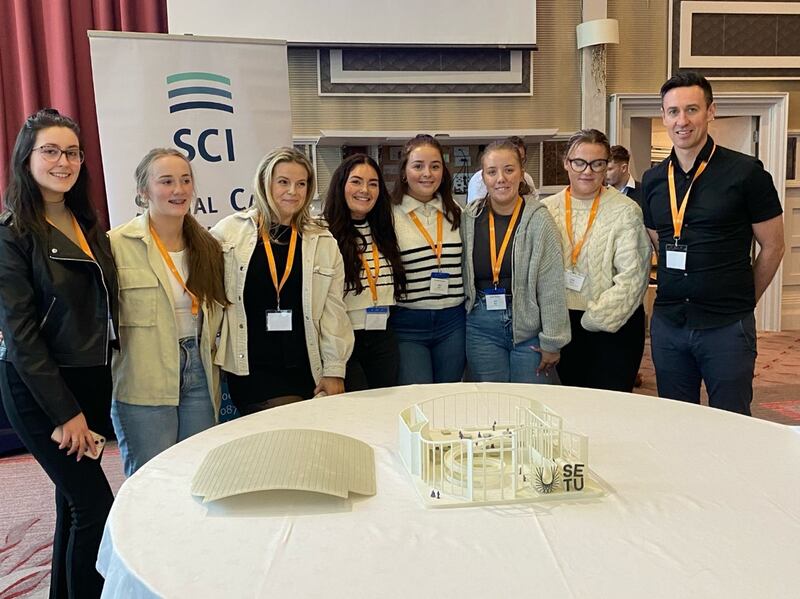Throw up a ramp for the wheelchair users. Let neurodivergent students go to the access office if they need help.
People with disabilities can often feel that the world requires them to adapt to it, even as their world makes minimal, often reluctant concessions to allow them to live in it. And, at third level, there remain a number of hidden barriers that discourage disabled students from engaging in learning.
But what if a new campus, designed from scratch, didn’t have inclusion as an afterthought, but as a guiding principle?
John Balfe, a lecturer in applied social studies and early childhood education programmes, at the South East Technological University (SETU) Wexford campus, and doctoral candidate at University College Cork, set out to answer this question.
Book your place at Europe’s leading summit for talent
‘A gas emergency would quickly turn into an electricity emergency. It is low-risk, but high-consequence’
How LEO Digital for Business is helping to boost small business competitiveness
‘I have to believe that this situation is not forever’: stress mounts in homeless parents and children living in claustrophobic one-room accommodation
“I was teaching a module on disability studies, and instead of using a medical model that looked at individual disabilities, I was encouraging my students to think critically about society’s role and responsibilities,” Balfe says.
“With SETU growing, the existing Wexford site has been earmarked for a new campus on a 55-acre site. We saw that there was an opportunity here to ensure that the new campus was accessible for everyone.

“Through N-TUTORR funding, the 12 students in the module worked with me to see what this would look like. We wanted to present the needs of students with disabilities first, and have the campus adapted to that. What could we, as a society and community, do to ensure that there was more universal access to education?
“There is a lot of good work happening in the university, and other universities, around access programmes and universal design for learning, but these can be sticking plaster approaches. The onus is often on the student to seek out the programmes and declare their disability, while individual lecturers may, or may not, take on training.
“We knew that, instead of the same old tiered lecture rooms and old staircases that are designed with one cohort of middle-class, able-bodied and relatively privileged students in mind, a different approach was possible.”
Putting up a ramp may solve one problem, but students with disabilities could have many others, says Balfe.
“What does the person do before they get to that ramp? What transport do they have? What about that kerb they can’t mount to get to their building? There are all sorts of psychological, social and emotional barriers to accessing education.”

The project team met people with disabilities in Wexford, and asked them about their daily lives, as well as the obstacles and barriers they face.
“We took a community-based, participatory research approach, using semi-structured interview techniques,” Balfe says. “We heard back about everyday struggles, such as how someone can be left stranded if their bus doesn’t have a wheelchair lift. Or that a person on the autism spectrum may be put off by the fear of a large, noisy, bustling, and bright lecture room, but where they nonetheless feel alone and excluded.”
The team also asked participants what they would need to attend third level in the first place.
“Many said that they just wouldn’t have considered it, because getting to a campus near them wasn’t an option. And, even if it was, they would struggle with funding. We heard from one participant, who has a visual impairment and uses a guide dog, that they had to climb several steps of stairs every day.
“Neurodivergent students, meanwhile, can benefit from softer, quieter spaces, a designated autism space or a sensory room like those at UCC.”
The voices of disabled people were central in this project, Balfe says.
“People with disabilities are often researched about, with others deciding what they think they need. But often they are not consulted themselves, so we wanted this project to bridge the gap between design, architecture, and social care.”
The project used digital technology to create a 3D prototype of an accessible campus, with a physical model produced by engineer Billy House. They engaged with computer-aided design (CAD) designers and architects over a six-month period, presenting the final prototype to the university president, who sits on the design team for the new campus.”
Balfe is hopeful that their ideas will be incorporated.
“Although we looked at a new campus, the principles and concepts are scalable, and I would hope that similar projects could happen elsewhere,” he says.
“Ultimately, I think this involves a change of thinking, so that rather than education being market-driven, there is more responsibility to put accessibility and inclusion at its heart in a real and meaningful way.”














